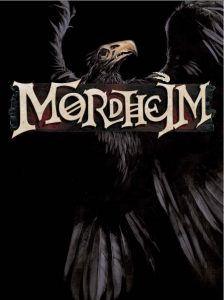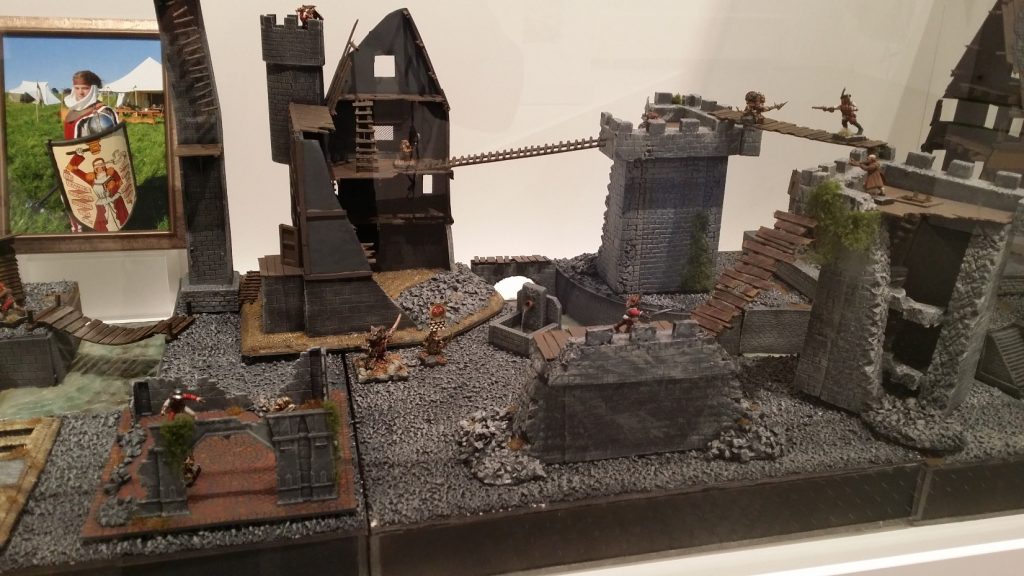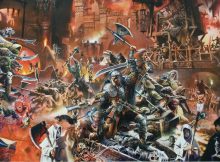You can’t get Mordheim anymore. Well, theoretically you can buy it used, if someone is willing to let go their copy, and the PDF rulebook is available if you know where to look. There is a fairly new computer game, but of course it’s just not the same. Getting the miniatures is beginning to be difficult and the original terrain pieces are close to impossible. Yet it remains popular, and played, 18 years after its initial release.
 Mordheim is one of Games Workshop’s line of miniature war games, a spinoff of Warhammer, the classic fantasy game. It was designed by Tuomas Pirinen with Rick Priestley and Alessio Cavatore and first released in 1999. Where in Warhammer the players controlled armies of dozens, even hundreds of miniatures, in Mordheim the focus is on a warband numbering maybe ten. It is set in the history of the Warhammer World, to a time when a great rock fell from the sky and demolished the city of Mordheim – presumably named with the assumption nobody knows German. The warbands of the game are after wyrdstone, magical shards of the meteorite, and fight over it in skirmishes across the ruins. The warbands available include a couple of stripes of human mercenaries, cultists both evil and allegedly good, witch hunters, undead, and the skaven, Warhammer’s iconic ratmen. More warbands based on the other races of Warhammer have been released in supplements and fan-written material online.
Mordheim is one of Games Workshop’s line of miniature war games, a spinoff of Warhammer, the classic fantasy game. It was designed by Tuomas Pirinen with Rick Priestley and Alessio Cavatore and first released in 1999. Where in Warhammer the players controlled armies of dozens, even hundreds of miniatures, in Mordheim the focus is on a warband numbering maybe ten. It is set in the history of the Warhammer World, to a time when a great rock fell from the sky and demolished the city of Mordheim – presumably named with the assumption nobody knows German. The warbands of the game are after wyrdstone, magical shards of the meteorite, and fight over it in skirmishes across the ruins. The warbands available include a couple of stripes of human mercenaries, cultists both evil and allegedly good, witch hunters, undead, and the skaven, Warhammer’s iconic ratmen. More warbands based on the other races of Warhammer have been released in supplements and fan-written material online.
The ruleset is likewise based on Warhammer – you roll to hit, the opponent rolls to save against taking a wound. Once they’re out of wounds, see if they’re just knocked down or out of action for the rest of the game. Modifiers from gear and character abilities apply. There are a few charts to consult, but gameplay is still fairly swift and a single scenario shouldn’t take more than a couple of hours to play through.
Apart from scale, Mordheim’s great attraction is the campaign mode. Since being struck down does not automatically mean a character dies nor a defeat that the warband’s story is over, the heroes and villains can gather experience, advance in rank, and develop new skills – or gain permanent injuries. Henchmen may become officers. Cultists may turn into mindless chaos beasts. It’s not a role-playing game as such, but it is a close relative.

After the boxed set sold out, Mordheim’s rulebook was released as a free PDF, downloadable from the Games Workshop website, where it was available for several years until being pulled in 2014. Nevertheless, the game lives on. The setting’s rich backstory and the comparatively simple game mechanics encourage a culture of co-creation. There are entire fan-written supplements such as Border Town Burning that take the skirmish game to new areas of the world, and the game’s Facebook group and fan forums are still lively. Though the official miniatures are mostly no longer sold, a player doesn’t need a lot and suitable stand-ins are sold by a dozen companies. Even in the absence of official support, the community thrives.
Mordheim is a hard town to kill.
Publisher: Games Workshop
Released: 1999
